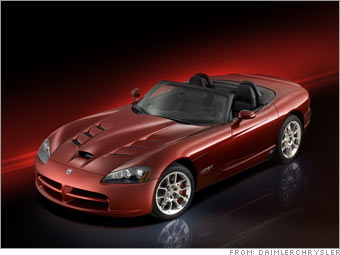Posted by Angus MacKenzie, Motor Trend
Dodge set the bar high when the original Viper SRT/10 hit the decks in 1992 packing 400 horses. Over the last decade-and-a-half, its displacement and power output have grown by ladder steps to the current car's 506 cubic inches and 510 horsepower.
Since then, however, Chevy's Corvette Z06 and Ford's supercharged Shelby GT500 -- each ripped with a minimum of 500 horsepower -- have arrived at the burnout contest.
The basis of the 2008 Viper (the 2006 model gets an extended run, and there is no 2007) is a powerplant that, short of its layout and basic architecture, is all new.
There were numerous reasons for this substantive overhaul. The first was to upgrade emissions compliance. Another was to quell the engine's rough and tumble nature at idle. The team also wanted to clean up the engine-bay packaging. And, of course, add more horsepower and torque.
It's still an overhead-valve, aluminum V-10 -- now at 8.4 liters by virtue of a 1mm bore increase -- yet no area of the engine's makeup or ancillary systems has gone untouched. And, most importantly, it now packs a 600 horsepower punch.
In keeping with the notion that form follows function, SRT focused most of its effort and product-development dollars into stuff that'll make the Viper go faster and run better. But a few pennies were spent on things that you can see.
The biggest visual clue to the power that lies beneath is a new louvered hood, which looks aggressive and increases engine bay airflow.
There's also a new optional wheel design called Razor and available colors are increased to eight; among the new ones are Shakespeare Green, Viper Violet, and Bright Orange. Body styles are unchanged from the current coupe and roadster configurations.
The Viper remains a halo car for Dodge; more about bragging rights and magazine covers than big volumes. Sales have loped along at an average of around 1,700 units a year for the last half-decade. One wonders how long the car will remain viable and in demand without a major reinvention. But SRT insists there's a business case to support it; hence, the substantive engineering investment made in the 2008 models.
Add a comment
| |

